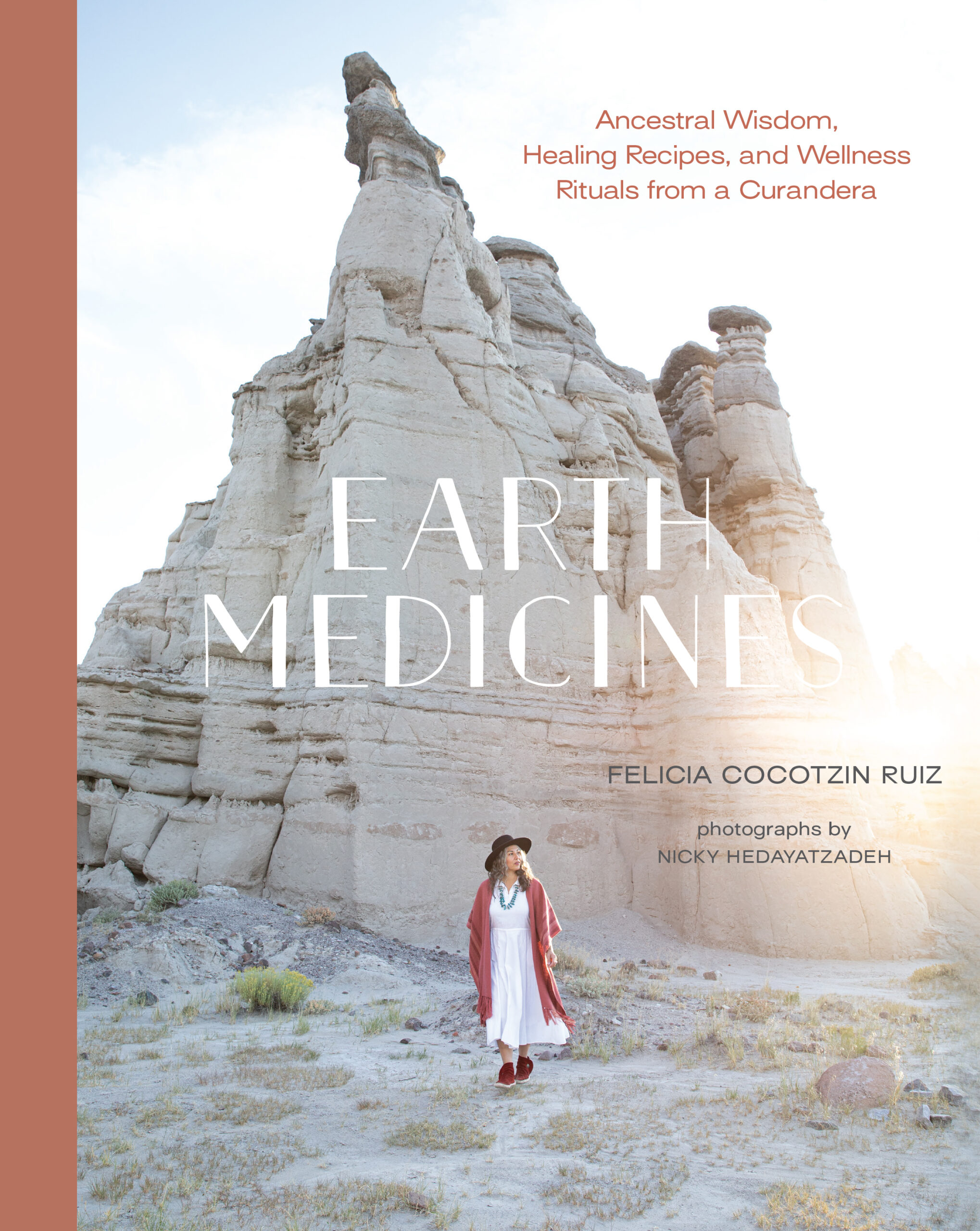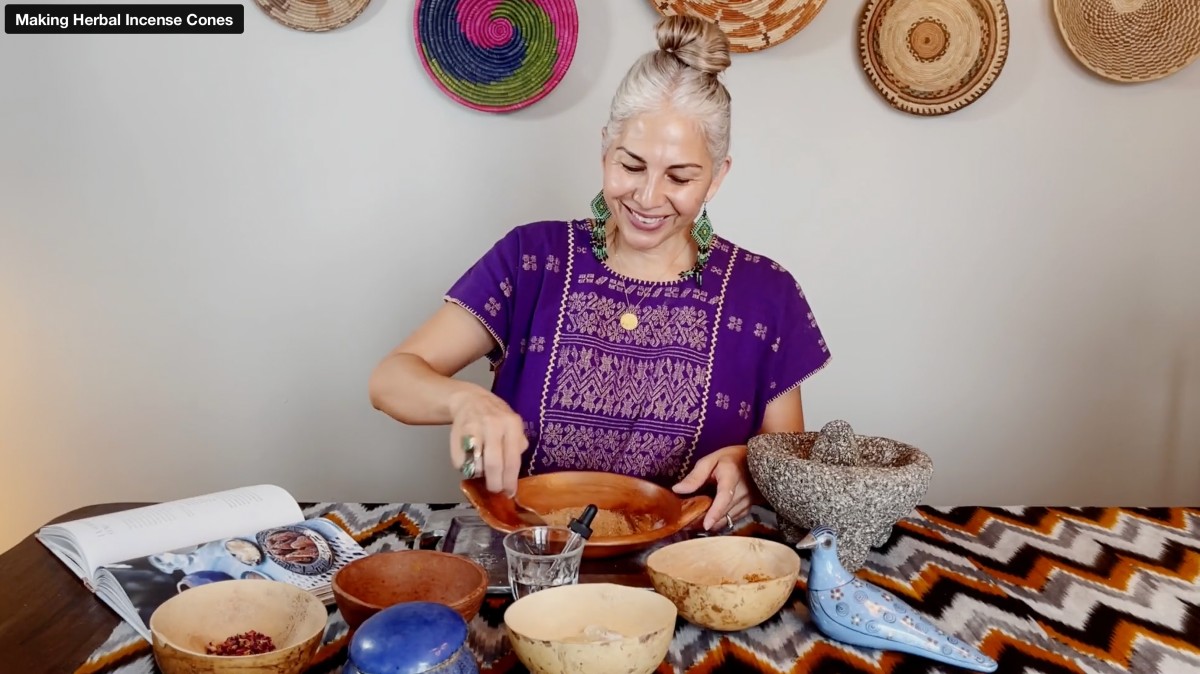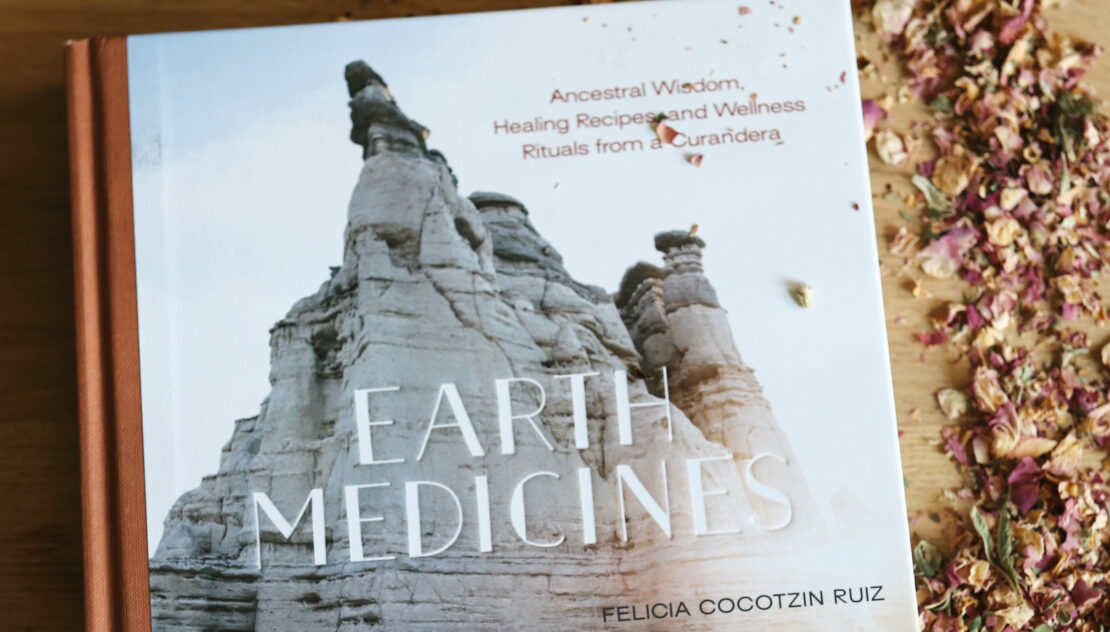
A Simple Incense Recipe Using Ethically Sourced Herbs
In Earth Medicines: Ancestral Wisdom, Healing Recipes, and Wellness Rituals from a Curandera, traditional healer, storyteller, and Indigenous foods activist Felicia Cocotzin Ruiz invites readers to connect with the the elements of Earth, Air, Fire, and Water that are so deeply integral to her curanderismo tradition. Felicia shares many aspects that shape her own personal practice, including food and herbal recipes as well as rituals grounded in the four elements, inviting readers to weave these into the rhythms of daily and seasonal life along with exploring their own cultural healing traditions. The following excerpt from the book explores Air and a simple way of connecting to this element as well as an incense recipe using ethically sourced herbs.

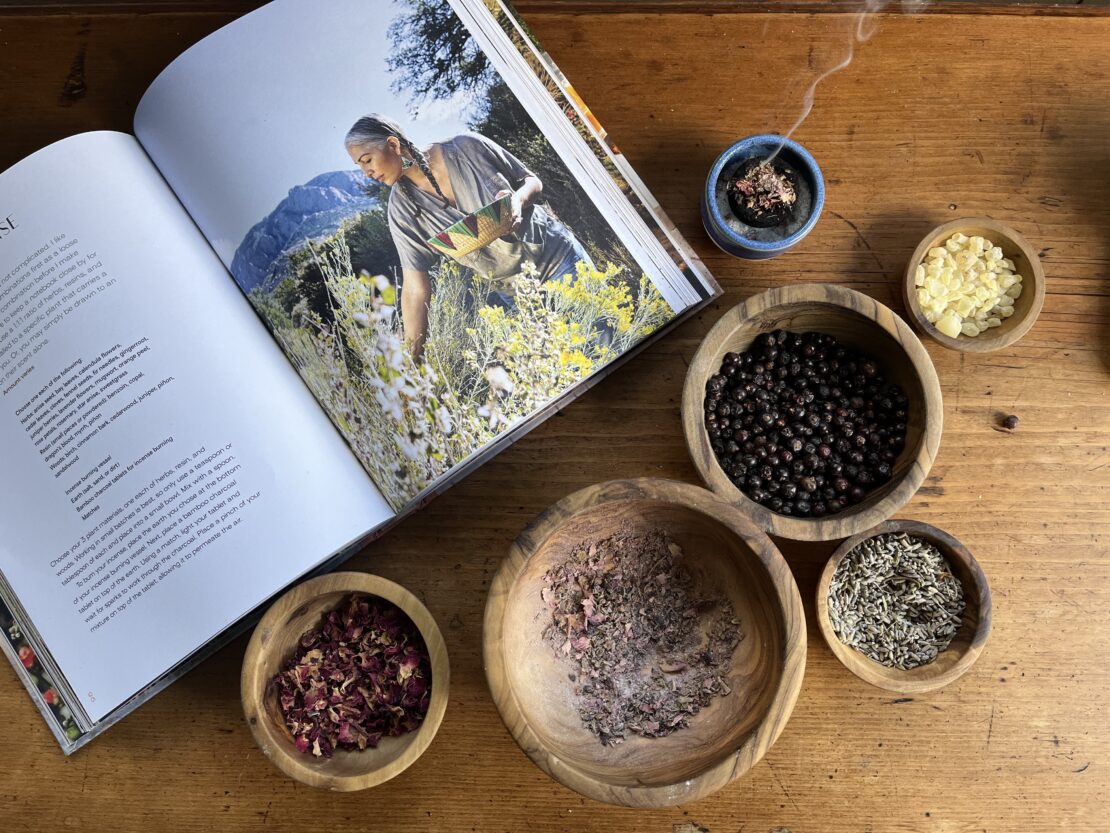
Photos by Herbal Academy
The following excerpt is from Earth Medicines: Ancestral Wisdom, Healing Recipes, and Wellness Rituals from a Curandera by Felicia Cocotzin Ruiz © 2021 by Felicia Cocotzin Ruiz. Photographs © 2021 by Nicky Hedayatzadeh. Reprinted in arrangement with Roost Books, an imprint of Shambhala Publications, Inc. Boulder, CO.
AIR REPRESENTS FREEDOM, MOVEMENT, AND DIRECTION
When its energy is subtle, I like the way it moves my hair and makes my whole essence feel carefree. Its personality at this intensity reminds me of my childhood, playing outside moments before the desert rains began. The scented wind would lure us outside, telling us that rain was on its way. We would feel it and breathe it in. However, when its personality turns forceful, different feelings trigger, urging us to go inside and take shelter. The wind tells us that change is coming. Air has a superpower that the other elements do not possess: it can carry the other elements, working as a messenger. Our bodies are in constant contact with Air, absorbing all its strengths and particles throughout the day. Immersed in its invisible magic, our skin reminds us of the cycle of life with the growth and death of its cells.
Ehécatl is the Aztec/Mexica metaphorical representation of wind. His name means “wind” in Nahuatl, and he is regarded as one of the many faces of the beautiful serpent Quetzalcoatl in our Creation stories. Ehécatl is depicted in many ancient art pieces wearing a conch shell (ehecailacocozcatl or “wind jewel”) on his chest that he uses to blow the world into motion. I believe there is much creative energy behind the motion of the wind and, when we are in the midst of wind’s presence, we are sensing intuitive direction or awareness. Our own breath is wind birthing our intentions, affirmations, gratitude, and desires. However, sometimes we need assistance in speaking these truths. Air can be used as a tool to encourage a focused mind and receive mental clarity by awakening vibrations in our bodies that encourage clear communication. Having heightened intuition, using your voice, opening your throat chakra—these are all benefits you can receive from working with the element of Air.
Physically, being outside in fresh Air has been shown to improve blood pressure, strengthen the immune system, and help the airways of the lungs to dilate more fully, improving their cleansing action. Most of the time, we are more aware of the Air in our immediate environment than the Air in our bodies. We may see a haze of pollution in the distance, sense stagnant Air in a closed space, or feel crisp Air during a morning walk. We tend to think of Air as being outside of us. Truth is, there are no defined boundaries with Air. As you read this, Air is entering your body, oxygen is flowing into your bloodstream, and carbon dioxide is being exhaled back into the Air you just took in. Our bodies simply borrow this life-giving element for a brief moment before it returns to its place of abundance. How beautiful it is that we have made this agreement!
Emotionally speaking, simply being outside in fresh Air fosters positive emotions and betters our ability to handle stress. I encourage you to get outside at least once a day or simply open a window if weather permits, and breathe in this element of awareness.
SACRED SCENTS INCENSE
I grew up in a culture where burning plant aromatics was part of our family’s culture and used in many ceremonial events such as Pueblo Feast Days, where cedar and pine torches are burned. I have been taught that burning our ancestral aromatics takes us back to the sacred places of our ancestors and helps us remember who we are. The use of fragrant smoke as a conduit to connect with the element of Air and our ancestors is powerful.
Burning aromatics has been used in traditional healing for time immemorial, which means it should be treated respectfully. I do my best to stay educated on plants that have now become endangered and threatened from recent trends resulting in overuse. Many indigenous plants, including California white sage and Peruvian palo santo, have been overharvested and now require time to regenerate. Copal resin, the plant aromatic I work with most, is harvested from bountiful and fast-growing trees in Mexico and Central America. I use it as the base for so many of my incense recipes along with sandalwood from plantations in Australia. When choosing plant material for your own personal blends, consider including plants that you can grow and ones that are ancestral to you. Also, source out ones that are in abundance and collected ethically.
Unbound Incense
Making your own loose incense is not complicated. I like experimenting with different combinations first as a loose incense to gauge their scent combination before I make them into cones, so be sure to keep a notebook close by for your recipes. I generally use a 1:1:1 ratio of herbs, resins, and woods. You may be called to a specific plant that carries a special meaning to you. Or, you may simply be drawn to an aromatic based on their scent alone.
Amount varies
Choose one each of the following:
Herbs: anise seed, bay leaves, calendula flowers,cedar leaves, cloves,
fennel seeds, fir needles, gingerroot, juniper berries, lavender flowers,
mugwort, orange peel, rose petals, rosemary, star anise, sweetgrass
Resin (small pieces or powdered): benzoin, copal, dragon’s blood, myrrh, piñon
Woods: birch, cinnamon bark, cedarwood, juniper, piñon, sandalwood
Incense burning vessel
Earth (salt, sand, or dirt)
Bamboo charcoal tablets for incense burning
Matches
Choose your 3 plant materials, one each of herbs, resin, and woods. Working in small batches is best, so only use a teaspoon or tablespoon of each and place into a small bowl. Mix with a spoon.
To burn your incense, place the earth you chose at the bottom of your incense burning vessel. Next, place a bamboo charcoal tablet on top of the earth. Using a match, light your tablet and wait for sparks to work through the charcoal. Place a pinch of your mixture on top of the tablet, allowing it to permeate the air.
Interested in learning more about making herbal incense? Members of The Herbarium can join Felicia in a video as she shows us how to make her La Guadalupana Cones incense recipe! You’ll find this helpful Making Herbal Incense Cones video in The Herbarium.
Interested but not yet a member of The Herbarium? Get access today with a 3 day trial for only $3!
The Herbarium is our ever-expanding, illuminating virtual collection of over 200 (and counting!) searchable monographs, unique intensive short courses on focused topics, and numerous articles, videos, ebooks, podcasts, and helpful downloadable resources. The Herbarium is crafted to help you learn and grow in your herbal journey!
Learn more and sign up for The Herbarium here.
Get a copy of Felicia’s book, Earth Medicines, via Shambhala Publications, her website here, or on Amazon.
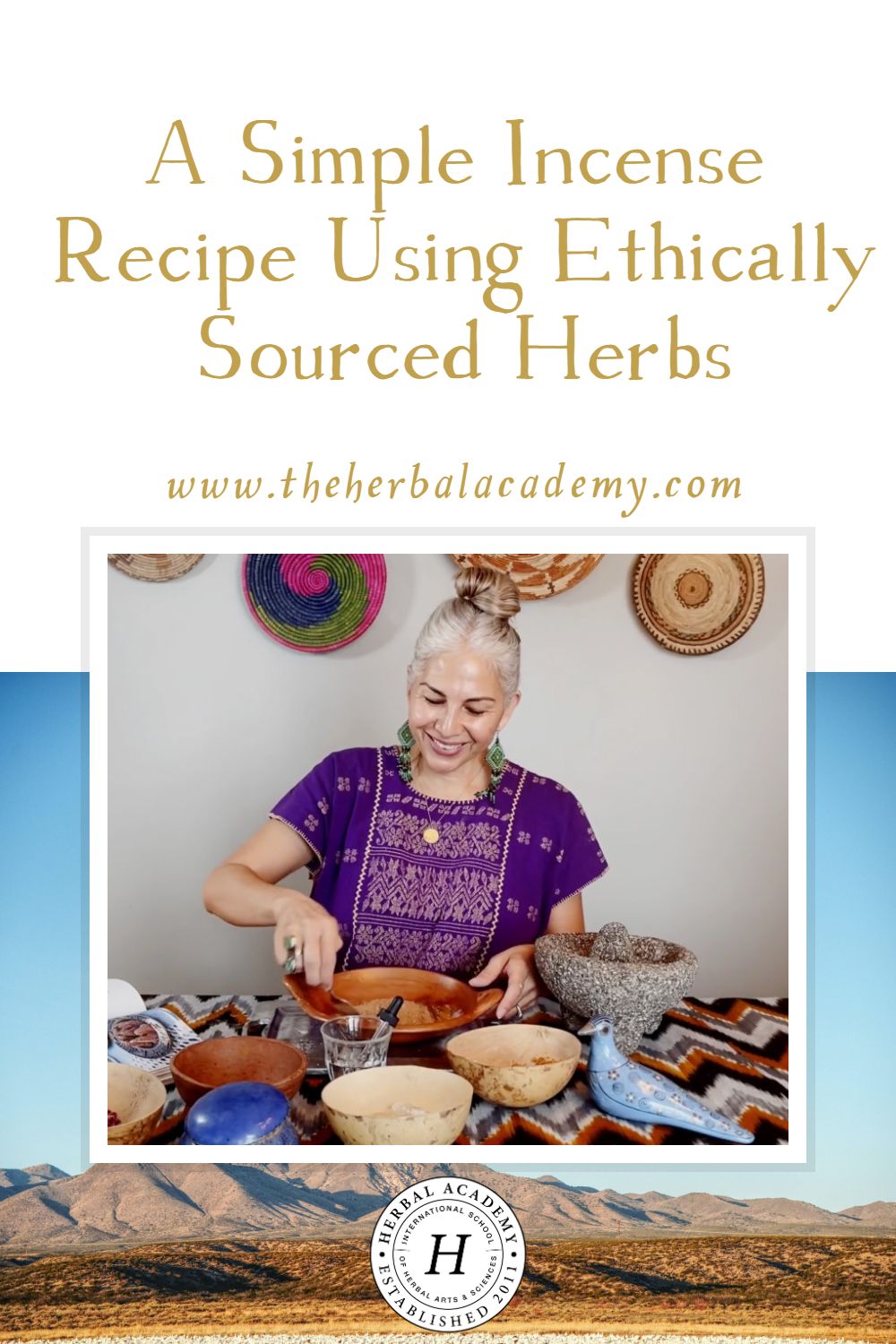
FELICIA COCOTZIN RUIZ (Tewa/Xicana) is a curandera and Indigenous foods activist whose work is deeply rooted in the healing properties of sacred plants. Sharing the Medicine of the People, Felicia weaves together stories of Indigenous wisdom with the intention of her dishes, applying “Culinary Medicine,” as named by one of her Maestras. Curanderas are traditional healers, who carry knowledge of foods, herbs, and other cultural remedies working with the body, mind, and spirit. Curanderismo has been practiced throughout the Americas for over five hundred years, with each healer offering a unique skillset applying their natural gifts, training, or cultural practices. With permission from her elders, Felicia shares her work with others through private consultations, workshops, and ceremony.

